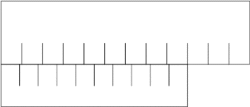Vernier acuity

Vernier acuity is a type of visual acuity that measures the ability to discern a disalignment among two line segments or gratings.[1] A subject's vernier acuity is the smallest visible offset between the stimuli that can be detected. Because the disalignments are often smaller than the diameter and spacing of retinal receptors, vernier acuity sometimes requires cortical processing and "pooling" to detect it. This phenomenon is also known as hyperacuity.[2] Vernier acuity develops rapidly during infancy and continues to slowly develop throughout childhood.[3] At approximately three to twelve months old, it surpasses grating acuity in foveal vision in humans.[1] However, vernier acuity decreases more quickly than grating acuity in peripheral vision.[4]
Vernier acuity is resistant to defocus, motion, and luminance, but is subject to practice effects and changes in attention.[3] After training, observers' threshold has been shown to improve as much as 6 fold.[5]
Testing
Vernier acuity is measured by asking participants to judge the offset between two parallel line segments with both eyes (binocular vision) or with each eye individually (monocular vision).[6]
Vernier measures in infants and non-verbal children must be done using electrophysiology techniques instead of purely behavioral techniques.[3]
See also
References
- 1 2 Robert H. Duckman (2006). Visual Development, Diagnosis, and Treatment of the Pediatric Patient. Lippincott Williams & Wilkins. pp. 36–48. ISBN 978-0-7817-5288-6.
- ↑ Sal Soraci; Kimiyo Murata-Soraci (2003). Visual Information Processing. Greenwood Publishing Group. p. 51. ISBN 978-1-56750-685-3.
- 1 2 3 Gordon Dutton; Martin Bax (25 October 2010). Visual Impairment in Children due to Damage to the Brain: Clinics in Developmental Medicine. John Wiley & Sons. p. 80. ISBN 978-1-898683-86-5.
- ↑ J.R. Brannan (23 January 1992). Applications of Parallel Processing in Vision. Elsevier. p. 95. ISBN 978-0-08-086740-3.
- ↑ Westheimer G, McKee SP. (1978) Stereoscopic acuity for moving retinal images. Journal of the Optical Society of America, 68(4):450-455 doi:10.1364/JOSA.68.000450
- ↑ Ian P. Howard Center for Vision Research York University; Brian J. Rogers Department of Experimental Psychology Oxford University (30 November 1995). Binocular Vision and Stereopsis. Oxford University Press. p. 180. ISBN 978-0-19-802461-3.